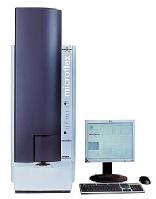Matrix-assisted Laser Desorption/Ionization (MALDI)
Matrix-Assisted Laser Desorption/Ionization (MALDI) is a soft ionization technique used in mass spectrometry, allowing the analysis of biomolecules (biopolymers such as proteins, peptides and sugars) and large organic molecules (such as polymers, dendrimers and other macromolecules), which tend to be fragile and fragment when ionized by more conventional ionization methods.
The spectometry component of the analysis is frequently combined with a position-tag based imaging component, allowing chemical map images to be produced, giving chemical resolution information on the resolution scale of around 1 micron.
 How does it work?
How does it work?
The ionization is triggered by a laser beam (normally a nitrogen laser). A matrix is used to protect the bio-molecule from being destroyed by direct laser beam and to facilitate vaporization and ionization.Applications:
Analysis of peptides and proteins, synthetic polymers, oligonucleotides, oligosaccharides, lipids, inorganics
Sample Handling Requirements:
Nanograms of a solid crystallised molecule of the sample
Complementary Techniques:
SEM, XRD, TEM, EF-TEM, LC-MS, GC-MS, Confocal Microscopy
Warwick Capability:
Contact:
Claire Gerard: c dot gerard at warwick dot ac dot uk / 07385 145064
Typical results format, and sample:
Status |
Availability |
 |
Warwick collect/analyse data |
 |
Warwick collect data |
 |
Available to user with expertise/ contribution |
 |
Spare capacity for collaborative research |
BOOK NOW |



